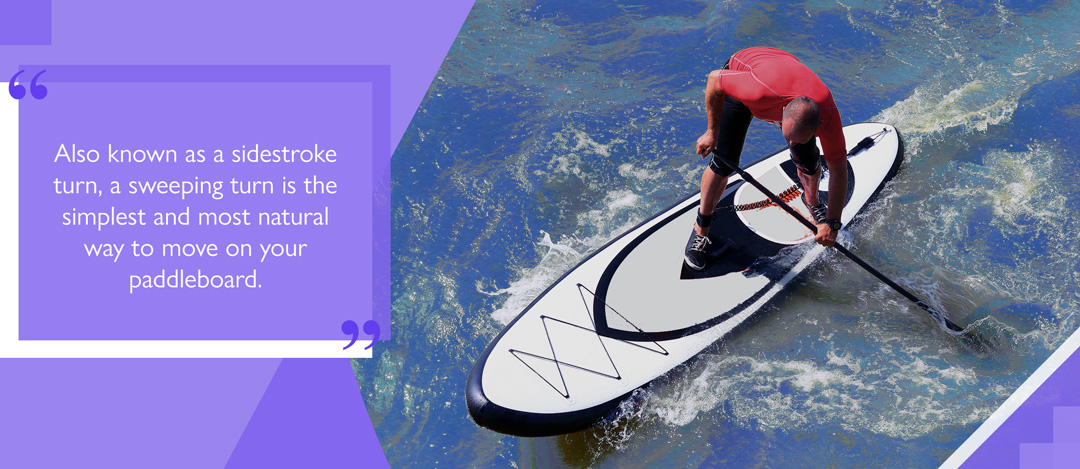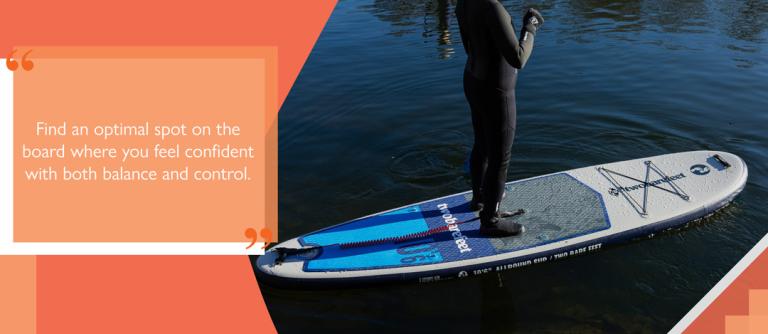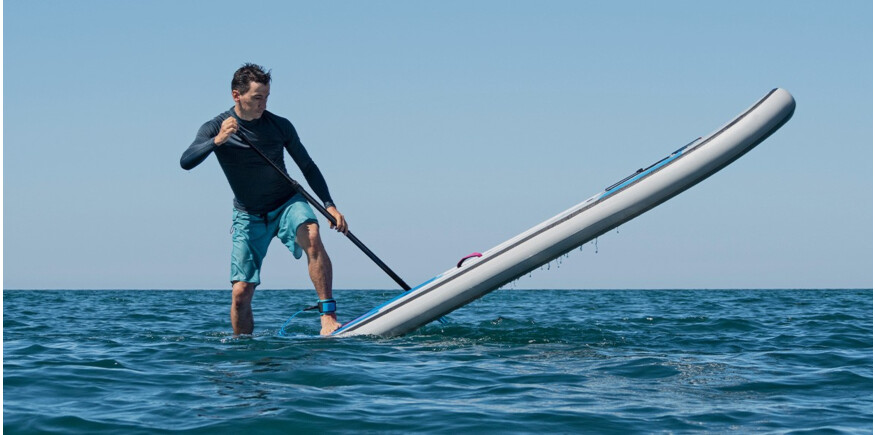Found the right inflatable SUP? Got all the SUP accessories you need? Well then, it’s time to head out onto the water and begin practising your moves!
Start by kneeling on your paddleboard to help you to learn the basics and establish control over your board. Then, with plenty of practice, you’ll soon be standing up, navigating your board at increased speed, and turning in different ways.
If you enjoy competitive or surf-style paddleboarding, it’s important to work on your manoeuvring skills since turning ability will impact how you handle waves or white water.
Below are some of the key manoeuvres and skills every paddleboarder should try to get to grips with.
SUP paddling in a straight line
Before focusing on turning, it’s important to understand the key to paddling in a straight line.
First, check your feet are evenly spaced on the board while standing shoulder-width apart. Try to distribute your weight as evenly as possible. Keep one hand firmly on the hilt of the paddle and the other about halfway down the shaft.
Before you get started with the actual paddling, you’ll need to perfect the placement of the paddle in the water. The blade should be angled slightly ahead of you and must be fully submerged. If the blade is not completely submerged at this stage, you may have to adjust the length of your paddle.
To move forward, pull the fully submerged paddle and sweep backwards in a straight line. When the leading arm is straight, raise the paddle out of the water and move it forward again in a circular motion, back to the starting point for your next stroke.
You will have to swap your leading arm regularly, moving the paddle to the other side of the board to maintain a straight course.
Keep your shoulders stacked and only look down to adjust your position on the board – maintain your focus in the direction you are going. Also ensure that your paddle is close to the board as possible, as this will propel you onwards in a straighter line and prevent your board from swerving away from the paddle.


.
.
Unlocking the secret of a sweeping turn
Also known as a sidestroke turn, a sweeping turn is the simplest and most natural way to move on your paddleboard.
To begin, find your balance around the centre of the paddleboard, keeping your feet apart to achieve stability and balance. Place your paddle to the front end of the board, on the opposite side you want to turn. So, if you want to turn left place the paddle to the right of the board.
Begin by twisting your torso, sweeping the paddle’s blade in a wide arc towards the tail of the board. Be sure to lean in towards the direction you are trying to turn, putting weight on the foot that you’re sweeping away from to steady yourself. Keep paddling on the same side until the board turns to your desired direction.
The art of the back paddle
If you want to turn your board quickly or reverse your direction, you could try back paddling. To do this, get into a similar stance as you would for a sweeping turn, and invert the blade so it is facing backwards. Then, on either side of the board, simply paddle backwards by placing the blade at the tail and drag the paddle towards the nose end. Make sure that you twist your torso to help with sweeping the blade in a wide arcing motion.
Performing a pivot turn on a paddleboard
Whether you’re stationary or moving, a pivot turn is the fastest way to change direction. It’s an ideal skill to bring to a surf paddleboard, when trying to negotiate the waves.
Seated position
A great way to start practising pivot turns is to perform them while seated. Begin by sliding yourself to the tail end of the board, until you find the spot where you’re most comfortable and balanced.
Once you’re in position, begin making forward sweeping strokes to see how the board responds. Leaning forward will give you more stability but will make the board less manoeuvrable. Leaning back will raise the nose out of the water, making it easier to quickly turn.


.
.
Standing up
To get into the right position: place one foot forward, pointing towards the nose; the other foot should be situated behind at a 45-degree angle. Check your heel lines up near to the centre line of the board as this will help stability.
Find an optimal spot on the board where you feel confident with both balance and control. Shifting your weight towards the back foot will submerge the tail under the water, while slightly elevating the nose. Again, this will make it easier to perform the turn.
A pivot turn will ideally be performed in one go, using a single, fluid arching motion to turn your board. Using a wide stroke, which is longer than a stroke used to just move forward, will help achieve this. Keeping low to the board by slightly bending your knees will also help you perform a one-stroke turn.
.
Inflatable SUPs and accessories
If you’re still looking for a SUP or thinking about upgrading your current setup, take a look at our extensive range of Two Bare Feet paddleboards and inflatable paddleboard accessories.
Our paddleboards are all designed to deliver outstanding quality and performance while catering for a range of riders and SUP disciplines.
If you would like more advice on paddleboarding from our reliable, knowledgeable, and experienced team, please don’t hesitate to get in touch.




